Ever wondered why your hair color sometimes turns out brassy or flat after a salon visit? The secret lies in understanding the hair color wheel. This simple tool holds the key to unlocking flawless color results every time we dye or tone our hair.
When we know how colors interact and neutralize each other, we gain total control over our look. Whether we’re aiming to brighten blondes, deepen brunettes or fix unwanted tones, the hair color wheel gives us the confidence to achieve salon-worthy results at home. Let’s discover how mastering this color guide can transform our hair game for good.
Understanding The Hair Color Wheel
Knowing how to read the hair color wheel gives us better results when coloring. We see that the wheel arranges primary hair colors—red, yellow, and blue—equally spaced apart. Looking across from each shade shows us its opposite, or complementary color. For example, purple sits opposite yellow, so purple-based toners cancel yellow brassy tones in blonde hair.
We always use the color wheel to decide whether to neutralize or enhance. Spotting unwanted green in our brown tones means reaching for a red-based corrector, since red and green are direct opposites. When we want to intensify copper or gold, choosing tones on the same side of the wheel strengthens those hues.
Noticing how color depth and undertone work together on the wheel helps us mix colors more confidently. Each step from one shade to the next builds complexity—blue and yellow combine for green, red and yellow create orange. Sliding between these hues lets us adjust warmth or coolness as needed.
We keep the wheel handy to stay ahead of common mistakes. Neutralizing unwelcome orange or brassiness after lightening always involves a blue-based toner. If our ash brown hair looks too cool, we balance things out with a golden or warm shade from the opposite side.
Every adjustment we make takes the wheel’s logic into account. By matching formulas to the wheel’s relationships, we can predict results and get closer to our ideal shade every time.
Exploring Primary Colors On The Hair Color Wheel
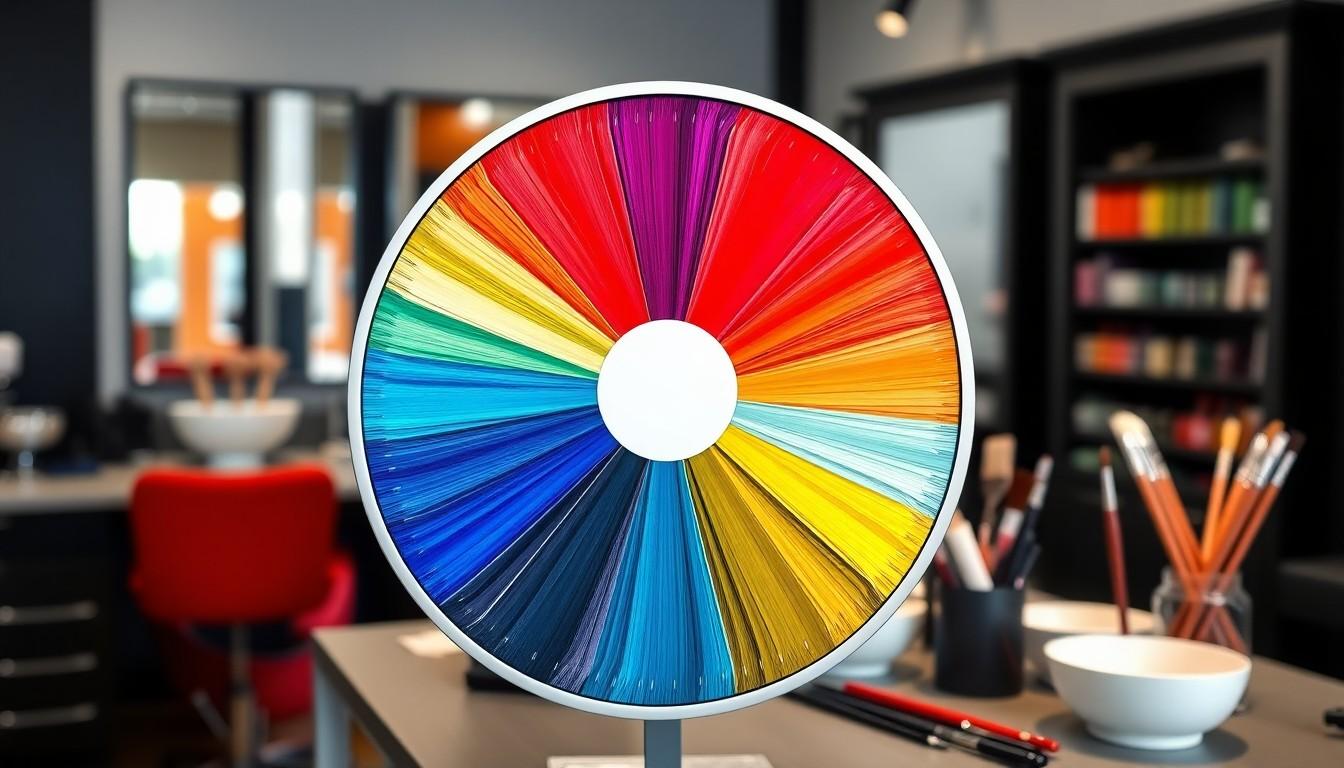
When we look at the hair color wheel, it’s clear that understanding primary colors is the key to unlocking every beautiful hair shade or correcting unwanted tones. These core colors—red, blue, and yellow—form the backbone of all hair color transformations.
Identifying Red, Blue, And Yellow
We see red as the source of medium tones and all things warm in hair color; it’s what gives richness to auburns and contributes to vibrant coppers. Blue stands out as the darkest primary, bringing coolness and depth to our blends and commonly helping to neutralize warm or brassy undertones. Yellow lights up the spectrum with golden warmth and is absolutely necessary for natural blondes and lighter shades. We rely on red, blue, and yellow as they simply can’t be mixed from any other shades, making them foundational in every formula. Whenever we want to know what’s really in a hair dye, recognizing these pure colors is our first step.
How Primary Colors Influence Hair Dye Choices
Mixing primary colors gives us full control over customizing any shade—we create green by combining blue and yellow, orange from red and yellow, and violet when blue and red come together. These combinations drive how we choose colors for warmth or coolness: yellow and red combinations result in warm, sunny hues, while adding blue tones tips formulas towards ash or cool territory. Neutralizing unwanted tones also depends on this knowledge. For example, blue cancels orange, red gets rid of green, and violet knocks out yellow. We can adjust highlights, correct brassiness, or deepen undertones just by understanding which primary to add or counter. Every time we blend, the primary colors in our hair dye decide the base, the vibrancy, and the final tone. This simple knowledge lets us make confident, precise choices, whether we’re going bold or making subtle, natural-looking tweaks.
Discovering Secondary Colors On The Hair Color Wheel
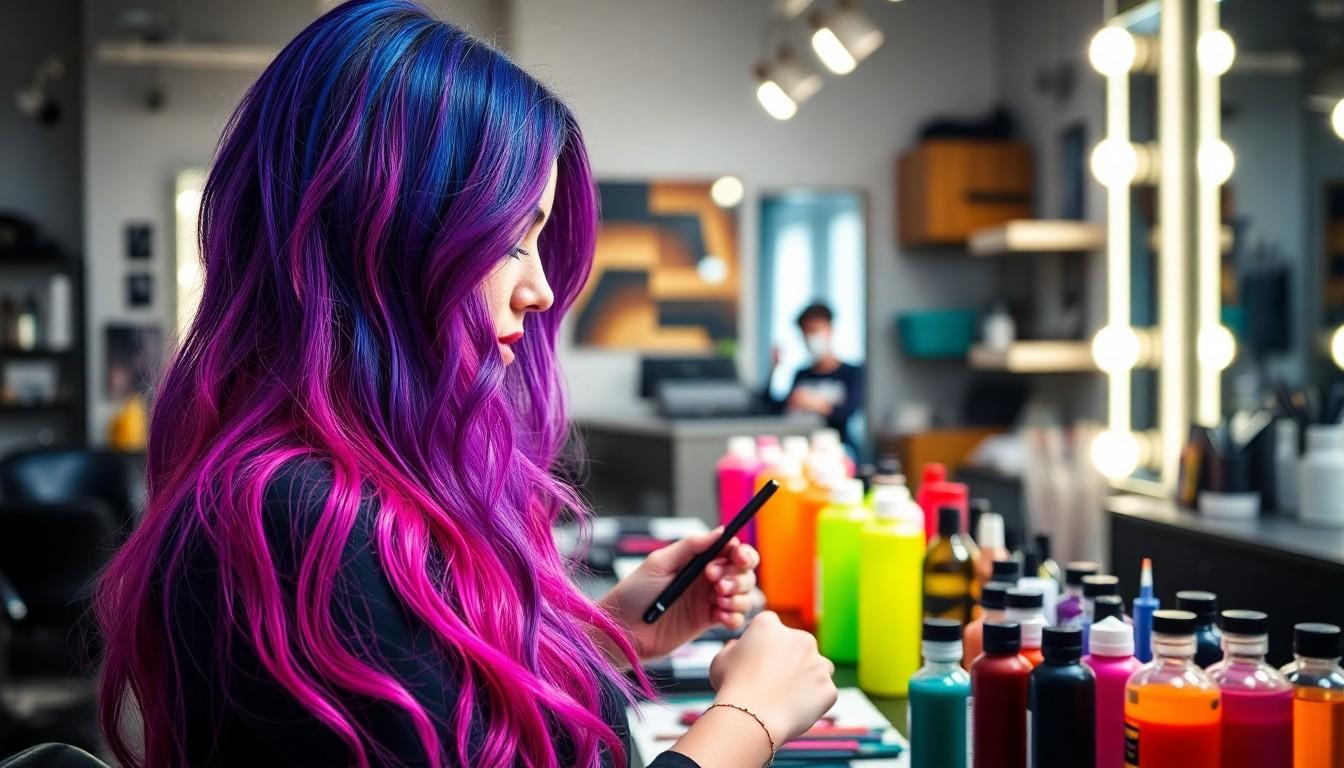
Secondary colors take center stage when we want to unlock fresh dimensions in hair color. These new hues form the basis for mastering tone corrections, creating custom shades, and boosting vibrancy in every hair coloring service.
Mixing Primary Colors For New Shades
We start with the three primary colors: red, yellow, and blue. Mixing equal parts of two primary colors gives us every secondary color. For example, combining blue and yellow makes green, while red paired with yellow creates orange. Blending red with blue results in violet. Every time we mix these, we’re setting the stage for both subtle tonal shifts and dramatic flavor in color formulas.
Popular Secondary Colors In Hair Coloring
Hair professionals rely on secondary colors to fine-tune results. Green is the go-to choice for neutralizing pesky red undertones—think about adjusting hair that’s turned unexpectedly warm. Orange helps inject warmth and is essential for golden blonde or coppery transformations. Violet saves the day when yellow tones threaten to muddle beautiful blondes, delivering those sought-after cool finishes. We spot these secondary colors everywhere in top salons, in formulas like teal (green/blue), maroon (violet/red), or golden orange (orange/yellow). Every secondary color, and the tertiary blends they inspire, empowers us to correct unwanted hues, personalize shades, and guarantee targeted results for every client.
Recognizing Tertiary Colors On The Hair Color Wheel

Tertiary colors help us fine-tune hair color results. These hues bridge primary and secondary shades, offering rich new possibilities when we want something less basic but not too bold.
Creating Tertiary Shades Through Mixing
We create tertiary shades by blending equal parts of primary and neighboring secondary colors. Mixing red with orange gives us red-orange, perfect for warmer, coppery results. Combining yellow and green forms yellow-green, which works great for earthy, grassy tones. For cool hues, we can mix blue and green to make turquoise or teal, adding a fresh pop to anyone’s hair. Blending blue with violet produces indigo, often chosen for deep, dramatic styles. Red mixed with violet gives us maroon, a favorite for those who love rich, sophisticated shades. Creating these combinations lets us address every client’s tone and complexion.
Trending Tertiary Hair Colors
Turquoise and teal (green-blue) dominate bold, statement-making looks on runways and social media. We see indigo (blue-violet) trending high as a go-to for anyone seeking striking, luxurious depth. Maroon (violet-red or violet-green) remains popular with people wanting a classy, multidimensional finish. Many stylists choose these tertiary colors to personalize results and complement all skin tones. As we work with these trending shades, mixing the correct proportions ensures the end look is vibrant, intentional, and right on trend.
Using The Hair Color Wheel For Corrective Coloring
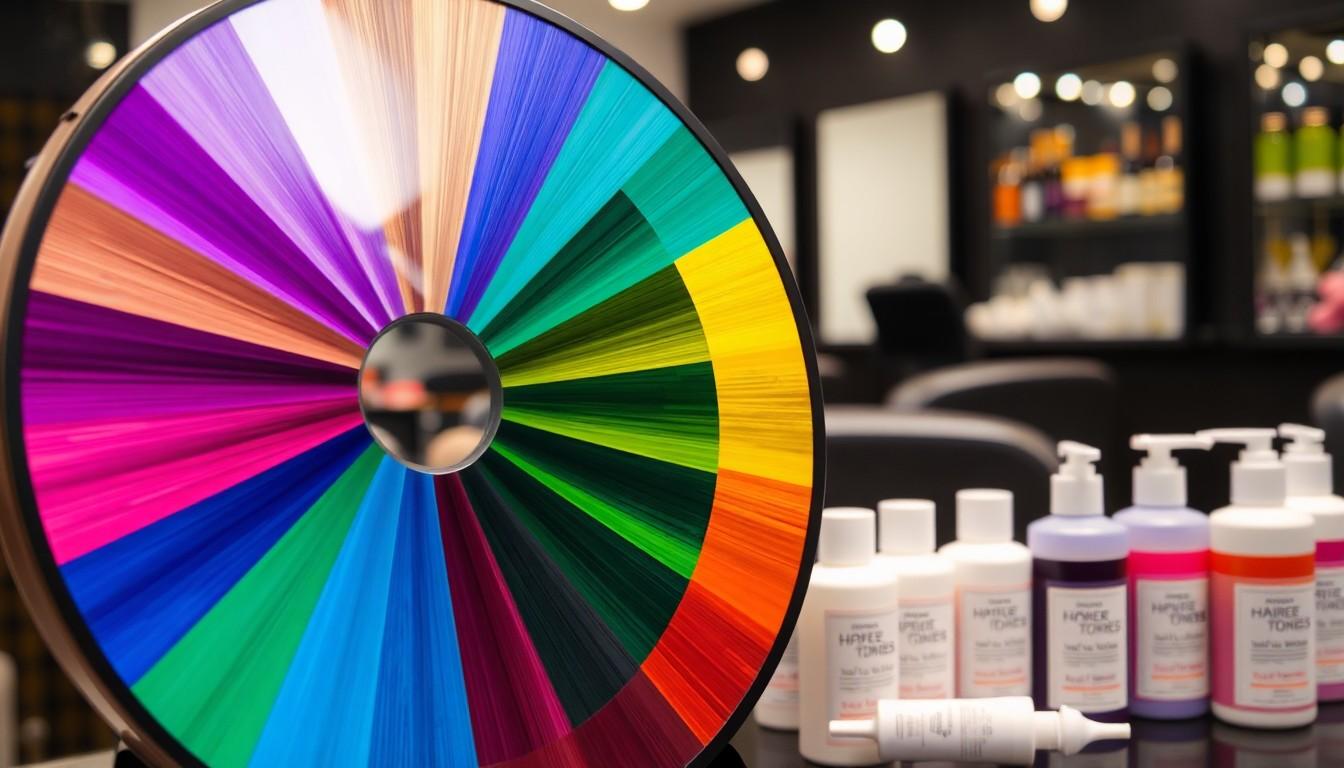
When we’re faced with unwanted tones after coloring, the hair color wheel gives us an easy way to quickly solve the problem. Connecting colors to their direct opposites on the wheel lets us neutralize off-tones and get back to the shades we want.
Neutralizing Unwanted Tones
Most of us have run into brassy yellows, stubborn oranges, or overwhelming reds in our hair. Looking at the wheel, we notice purple sits across from yellow, just like green sits across from red. Applying these principles, purple-based toners knock out yellow brassiness—for example, toning over light blonde hair with violet cancels those golden tinges. Next, green becomes our go-to for neutralizing red; it’s especially helpful with brunettes whose hair goes too warm. For orange, we see blue and purple both help, but often a toner containing blue will best cancel orange in medium brown shades. Consistent success with neutralization comes from always matching the correct complementary color to the unwanted tone.
Choosing The Right Toner Based On The Wheel
First, we identify whether our hair issue is more yellow, orange, or red. From there, using the wheel, we pick a toner with the right base pigment to fix the problem. For instance, someone with yellow tones would reach for a violet toner—blondes especially benefit from these cool formulas. Dealing with unwanted orange leads us to blue or blue-violet toners; these are perfect for light brown hair that’s turned coppery. Red tones call for a green-based toner; mixing a bit of Ash or green into our formula quickly brings brassiness down, especially for dark brunettes. As we decide how intense our correction needs to be, we can adjust the percentage of neutralizing pigment—25 percent Ash for a subtle fix, up to 75 percent for stubborn warmth. This simple, wheel-based method helps us choose corrective products with total confidence.
Applying The Hair Color Wheel To Achieve Vibrant Results
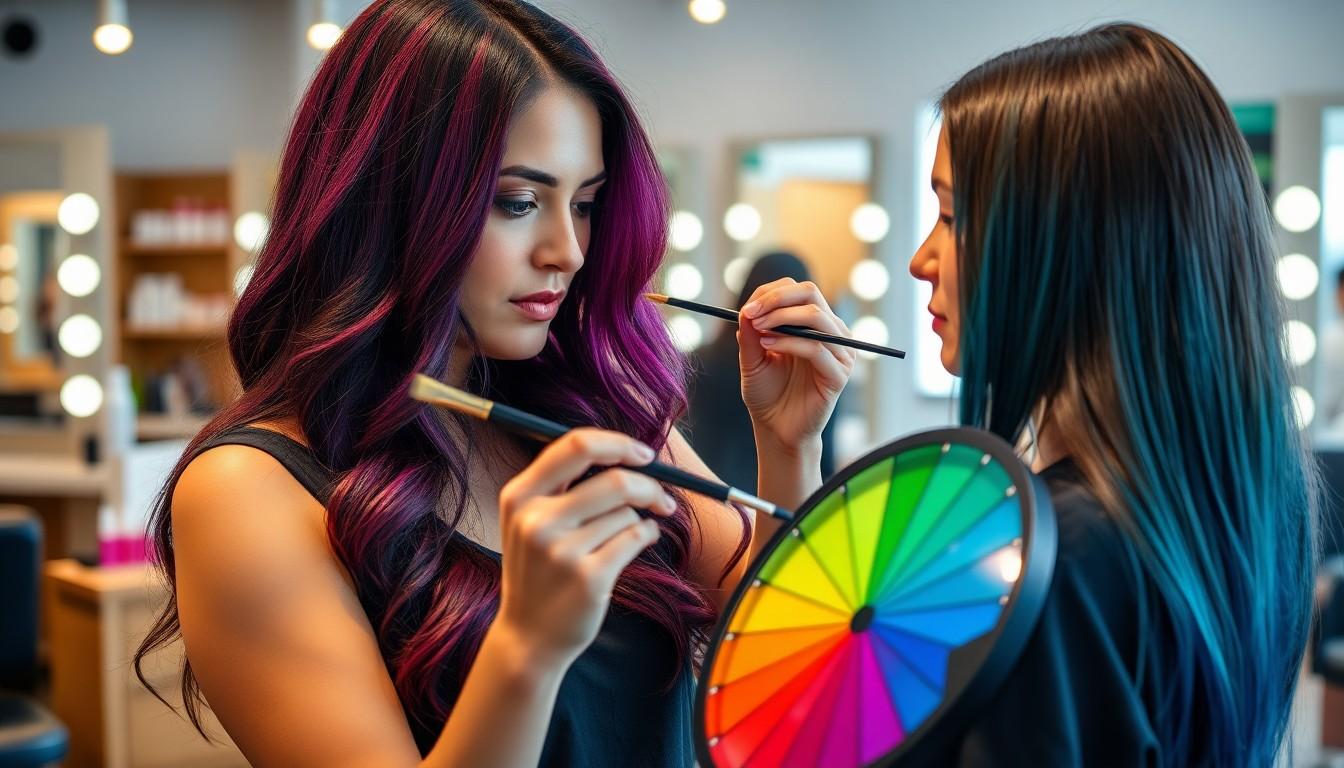
Let’s use the hair color wheel to unlock hair color choices that look bold, balanced, or natural. When we understand the relationship between hair color tones, we easily capture attention with vibrant transformations or keep things beautifully subtle.
Selecting Complementary Colors For Bold Styles
Pairing colors that sit directly across from each other on the wheel grabs the spotlight. Let’s say we want green eyes to pop. We’d choose hair shades with red undertones—like red-violet or red-orange—because red complements green best. Many stylists use opposite colors on the wheel when creating edgy highlights or color-blocked styles. These combinations bring contrast and vibrancy, just like pairing blue-violet with blonde for a cool, fashion-forward effect. Several popular hair trends rely on this “opposites attract” approach, which is why unusually bold looks—think red and green streaks or violet and yellow accents—turn heads and show off our style confidence.
Improving Natural Colors With The Wheel
Working with natural hues often means neutralizing or amplifying undertones. Whenever blonde hair looks too golden or brassy, we reach for violet-based toners since violet lies opposite yellow on the wheel. Applying a green-based product instantly quiets unwanted red in brunette shades—this method uses the wheel’s balancing power for seamless correction. Toning treatments after lightening commonly pull warm notes like orange or yellow, so colorists rely on blue or violet hues to cool things down. Professionals carefully select these toners to enhance what’s naturally there, creating rich, balanced color that feels effortless. Using the wheel as our guide, we boost natural shade while fixing any pesky, unwanted tones.
Avoiding Common Mistakes With The Hair Color Wheel
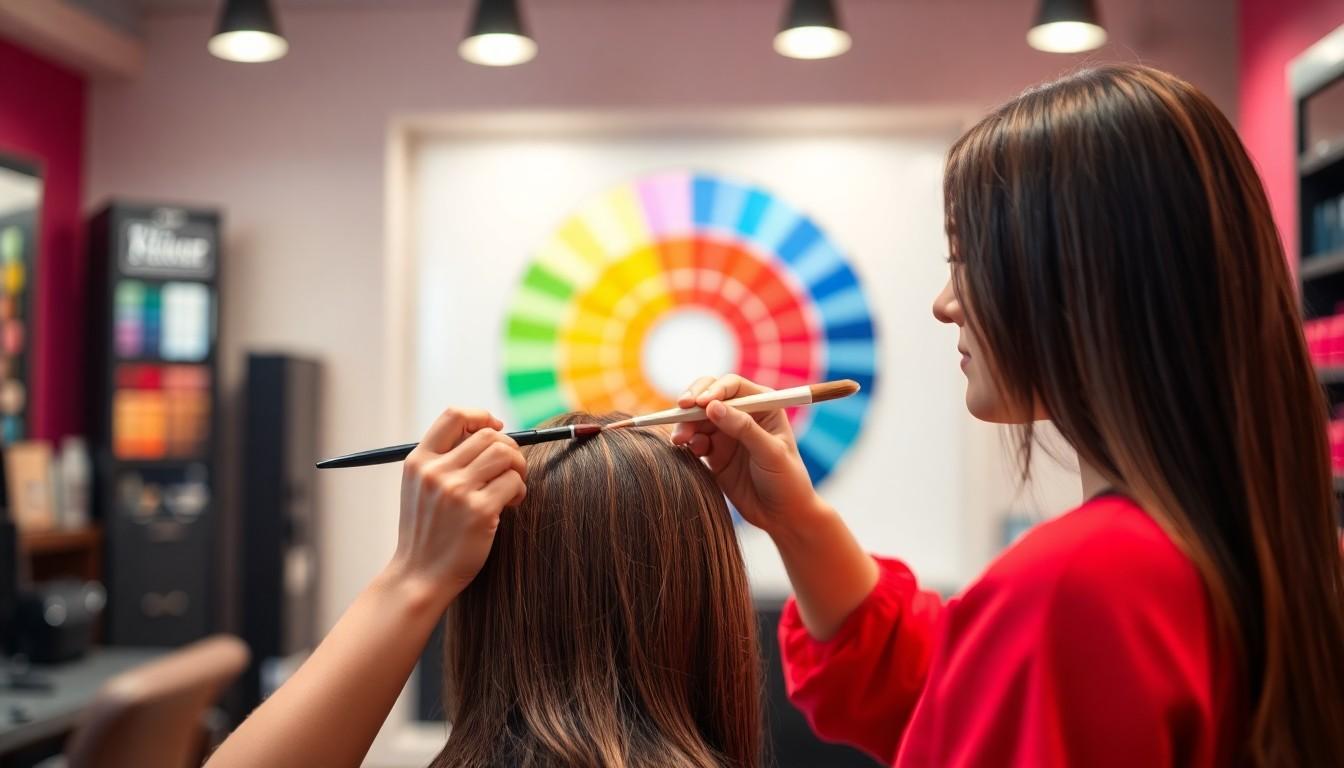
Let’s face it, perfect hair color is never accidental—it’s all about understanding and smart application. When we use the hair color wheel with intention, our results look balanced, vibrant, and true to our vision.
Misunderstanding Undertones And Color Placement
We see undertones as the secret sauce for beautiful hair color. Many of us assume what’s on the box is what we’ll get, but ignoring undertones leads to surprises. Colors that sit opposite on the wheel—like red and green or yellow and violet—actually cancel each other out. For example, trying to fix red undertones in brown hair? Grabbing a green-based toner is our best bet for neutralizing them. Sometimes we want a soft, natural blend, and using analogous shades—like blue, teal, and green next to each other—helps us nail that smooth transition. By skipping these basics, we risk a mismatch between our root color and the ends, or worse, vivid but clashing hues. Always match our underlying tones to the right spot on the color wheel for a flawless result.
Overcoming Patchiness And Brassiness
Patchiness ruins that salon-fresh look every time. We handle this by applying color evenly with a tint brush, not our hands, and checking we saturate each section. Timing matters too. If we’re impatient or distracted, we might over-process the top and under-treat the back, leaving hair with inconsistent shades. Pre-treating hair to open the cuticle—especially if it’s resistant—makes sure our color grabs evenly.
Brassiness is a struggle most blondes know all too well. Yellow or orange hues sneak in as hair lightens. We use the color wheel here: purple neutralizes yellow and blue counteracts orange. Ash-based toners guarantee a cool, glossy finish when warmth creeps in. Leveling up with a lightening curve ensures we lift hair just enough before toning. This step means our end color feels deliberate and sophisticated, instead of patchy or brassy. If we ever feel lost, consulting a pro never hurts—sometimes healthy, flawless color is just one conversation away.
Conclusion
When we understand the hair color wheel, we open up endless possibilities for creative and corrective hair color. It gives us the confidence to experiment with new shades or fine-tune our favorite looks without fear of unwanted surprises.
With this knowledge, we’re empowered to make smart choices—whether we’re toning down brassiness, adding bold highlights, or simply improving our natural color. The hair color wheel isn’t just a tool for professionals; it’s our secret weapon for achieving salon-worthy results at home.
Frequently Asked Questions
What is the hair color wheel and why is it important?
The hair color wheel is a visual tool that shows how colors interact, with primary, secondary, and tertiary hues arranged in a circle. It’s important because it helps you understand which colors neutralize or enhance each other, making it easier to correct or achieve your desired hair color.
How can the hair color wheel help correct unwanted tones in my hair?
By using the hair color wheel, you can identify the complementary color that will neutralize unwanted tones. For example, purple cancels yellow, blue cancels orange, and green cancels red. Applying the right toner or color corrector leads to more even, natural-looking results.
What are the primary hair colors and how do they affect hair dye results?
The primary hair colors are red, blue, and yellow. They form the base of all other colors. By mixing them, you can create endless shades and adjust the warmth or coolness of your hair color, helping to customize your look or correct unwanted hues.
How are secondary and tertiary hair colors used in hair coloring?
Secondary colors—orange, green, and violet—are made by mixing two primary colors and are essential for correcting and enhancing tones. Tertiary colors, like teal or maroon, bridge primary and secondary shades for more nuanced, trendy hair color options and detailed tone correction.
Which color should I use to neutralize brassy yellow or orange tones in my hair?
To cancel yellow tones, use a purple-based toner. To neutralize orange tones, choose a blue-based product. Select a toner with the right base pigment for targeted correction and always follow the instructions for best results.
How do I avoid common hair color mistakes at home?
Avoid mistakes by understanding your hair’s undertone and using the color wheel to pick the right products. Apply color evenly and follow timing guidelines. Start with a strand test when using a new shade and do not skip professional help if you’re unsure.
Can I use the color wheel to make my natural hair color look better?
Yes! The color wheel helps you enhance your natural shade. For example, violet toners reduce brassiness in blondes, while green-correcting products calm red undertones in brunettes. This allows you to achieve a more balanced and vibrant hair color.
Are trending hair colors achieved using the hair color wheel?
Absolutely. Popular shades like teal, indigo, and maroon require careful mixing of primary, secondary, and tertiary colors. Understanding the color wheel empowers you to create on-trend styles with intentional, vibrant results that suit your complexion.
Do I need professional help to use the hair color wheel effectively?
While the color wheel makes home coloring easier, consulting a professional is helpful, especially for major corrections or drastic changes. Hair experts have experience in precise color mixing and application, ensuring healthier hair and flawless color outcomes.
How can I fix patchy or uneven hair color?
Patchiness often results from uneven application or incorrect timing. Use the color wheel to select a toner that balances the dominant unwanted hue, and apply evenly across sections. If problems persist, seek professional advice to prevent further damage.







